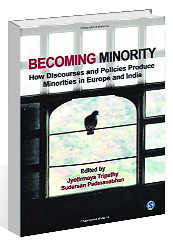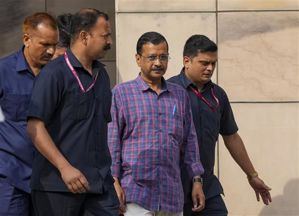
Becoming Minority: How Discourses and Policies Produce Minorities in Europe and India Ed by Jyotirmaya Tripathy and Sudarsan Padmanabhan.Sage.Rs 995
Sunita Pathania
The term minority refers to a small group of people distinct from others in terms of race, religion, language or opinion on a topic. Questions like when did minority factions emerge, how did these become a segment for political analysis, policy research as well as popular discourse are answered in current scholarship on minorities and cultural studies.
The volume Becoming Minority, as the title suggests, draws attention towards the popular notion of minority identity, defined by race, ethnicity and gender. Why minority is constructed, what makes one consider oneself a minor, how is the minor perceived, what narrative techniques are used to define the status, how do groups perform, are some of the important issues raised in the volume. The book is not merely about minority culture, but has as its framework the processes that define minorities through discourse and representation.
It is well argued that minority is not the ‘container of some unchanging core ideals,’ but comes into existence in the very ‘act of representation’. At the heart of discussion is the question, whether the concept of minority is self-imagined or imposed from outside or is both. Minority and majority categories do not exist as binary opposition, but are discursive and constructed entities. Therefore, the process of becoming a minority is continuous and largely dependent on political culture and its needs. As a matter of fact, political culture is the carrier of group identity and politics.
Drawing on the European and Indian experiences of engaging with cultural diversities from within a democratic framework, the book also explores how cultural diversity and religion operate in Europe and India. The articles in the first part of the book, subtitled Making of Minority, are devoted to theoretical and conceptual issues of minority-identity formation. Moving away from the conventional wisdom of an essentialist view of minority identities, the authors highlight the processes through which minorities are ascribed an identity and also identify themselves. The need to add to history identity assertion is stressed upon.
The European Experience which constitutes the second part of the book relates to specific historical realities and case studies of minorities in Europe. In the chapter titled, Manufacturing Blackness at the Turn of Twentieth Century in France, Abdoulaye Gueye argues that construction of racial minority in France with particular emphasis on blackness is more of a sociological construct than an essence.
The other chapters in this part deal with ethno-cultural identity manufacturing and their implications in Sweden, Denmark, Scotland, the Netherlands, Western Thrace and Great Britain.
The last and the most interesting part of the volume is devoted to The Indian Experience. In his handling of Minority Question in India, Bishnu Mahapatra engages the reader with question on institutions, policies and government technologies. Because of government policies, the minority groups ‘experience their identities and existence as constantly changing’. In Indian State and the Minority’s Right to Culture, Malvika Menon draws our attention to the fact that community-based identities in colonial times were institutionalised by the modern Indian State as cultural and not political categories.
The fate of Indian minorities is linked to the idea of secular democracy and its efficacy as a state practice. A democratic polity is associated with the institution to practice ones religion and way of life in the form of rights and entitlements, which earlier were dependent on the consent of the dominant group in pluralist societies. In the West, the failure of liberal democracy to ensure cultural equality led to multicultural approach in Europe. In India, the minority question remains central to secular and communal debate. Another articles in this section focuses on the religious minority as an emotional subject.
The book manages to highlight the adequacies and inadequacies of the existing theoretical understanding of minority. Though spaced over two continents, the various articles in the book are strung coherently together within the framework of Becoming Minority. Indeed an immense contribution to minority studies.



























